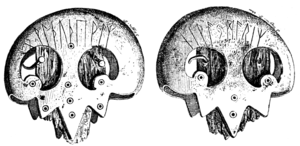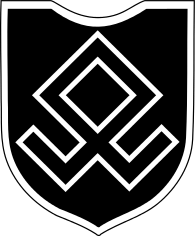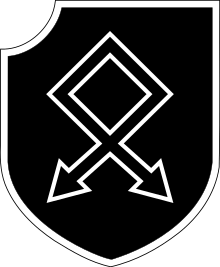Odal (rune)
The Elder Futhark Odal rune (ᛟ), also known as the Othala rune, represents the o sound. Its reconstructed Proto-Germanic name is *ōþalan "heritage; inheritance, inherited estate".
| Name | Proto-Germanic | Old English |
|---|---|---|
| *Ōþalan | Ēðel | |
| "heritage, estate" | ||
| Shape | Elder Futhark | Futhorc |
| Unicode | ᛟ U+16DF | |
| Transliteration | o | œ |
| Transcription | o, ō | œ, oe, ōe |
| IPA | [o(ː)] | [eː], [ø(ː)] |
| Position in rune-row | 23 or 24 | |



It was in use for epigraphy during the 3rd to the 8th centuries. It is not continued in the Younger Futhark, disappearing from the Scandinavian record around the 6th century, but it survived in the Anglo-Saxon Futhorc, and expressed the Old English œ phoneme during the 7th and 8th centuries. Its name is attested as ēðel in the Anglo-Saxon manuscript tradition.
The rune is encoded in Unicode at code point U+16DF: ᛟ.
Name and etymology
The Common Germanic stem ōþala- or ōþila- "inherited estate" is an ablaut variant of the stem aþal-. It consists of a root aþ- and a suffix -ila- or -ala-. The suffix variant accounts for the umlauted form ēþel. Germanic aþal‑ had a meaning of (approximately) "nobility", and the derivation aþala‑ could express "lineage, (noble) race, descent, kind", and thus "nobleman, prince" (whence Old English atheling), but also "inheritance, inherited estate, property, possession". Its etymology is not clear, but it is usually compared to atta "father" (cf. the name Attila, ultimately baby talk for "father").
There is an apparent, but debated, etymological connection of Ol to Adel (Old High German adal or edil), meaning nobility, noble family line, or exclusive group of superior social status; aristocracy, typically associated with major land holdings and fortifications.[1]
The term oþal (Old High German uodal) is a formative element in some Germanic names, notably Ulrich and variants;, the stem aþal is more frequent, found in Gothic names such as Athalaric, Ataulf, etc. and in Old High German names such as Adalbert,[2] and Adel. Unrelated, but difficult to separate etymologically, is the root aud- "wealth, property, possession, prosperity";[3] from this root are names such as Edmund and other English names with the ed prefix (from Old English ead), German Otto and various Germanic names beginning with ed- or od-. Possibly related is euþa, euþu a word for "child, offspring" (attested in Old Norse jóð, and possibly in the name of the Iuthungi).
Odal was associated with the concept of inheritance in ancient Scandinavian property law. Some of these laws are still in effect today, and govern Norwegian property. These are the Åsetesrett (homestead right), and the Odelsrett (allodial right). The tradition of Udal law found in Shetland and Orkney in Scotland, and also in Manx law on the Isle of Man, is from the same origin.
Elder Futhark o-rune

The o-rune is attested early, in inscriptions from the 3rd century, such as the Thorsberg chape (DR7) and the Vimose planer (Vimose-Høvelen, DR 206). The letter is derived from a Raetian variant of the letter O. The corresponding Gothic letter is 𐍉 (derived from Greek Ω), which had the name oþal.
Wolfgang Krause (1964) has speculated that the o rune is used as an ideograph denoting possession in the Thorsberg chape inscription. The inscription has owlþuþewaz, read by Krause as O[þila] - W[u]lþu-þewaz "inherited property - the servant of Wulþuz".[4]
The odal rune is found in some transitional inscriptions of the 6th or 7th century, such as the Gummarp, Björketorp and Stentoften runestones, but it disappears from the Scandinavian record by the 8th century. The Old Norse o phoneme is now written in Younger Futhark with the same letter as the u phoneme, the Ur rune.
Anglo-Saxon œ-rune
The Anglo-Saxon runes preserve the full set of 24 Elder Futhark runes (besides introducing innovations), but in some cases these runes are given new sound values due to Anglo-Frisian sound changes. The odal rune is such a case: the o sound in the Anglo-Saxon system is now expressed by ōs ᚩ, a derivation of the old Ansuz rune; the odal rune is now known as ēðel (with umlaut due to the form ōþila-) and is used to express an œ sound, but is attested only rarely in epigraphy (outside of simply appearing in a futhark row). Epigraphical attestations include:
- the Frisian Westeremden yew-stick, possibly as part of a given name Ƿimod (Ƿimœd)
- the Harford (Norfolk) brooch, dated c. 650, in a finite verb form: luda:gibœtæsigilæ "Luda repaired the brooch"
- the left panel of the Franks Casket, twice: tƿœgen gibroþær afœddæ hiæ ƿylif "two brothers (scil. Romulus and Remus), a she-wolf nourished them".
The Anglo-Saxon rune poem preserves the meaning "an inherited estate" for the rune name:
|
ᛟ byþ oferleof æghƿylcum men, |
[An estate] is very dear to every man, |
Modern use
Germany


The rendition of the Odal rune with wings or feet (serifs) was the emblem of ethnic Germans (Volksdeutsche) of the 7th SS Volunteer Mountain Division Prinz Eugen operating during World War II in the Nazi Germany-sponsored Independent State of Croatia. This rendition has been used by the Neo-Nazi Wiking-Jugend in Germany, and in South Africa by the Anglo-Afrikaner Bond, the Boeremag, the Blanke Bevrydingsbeweging,[5] and the Italian neo-fascist group National Vanguard. This particular rendition has no historical significance outside of Nazi Germany. Because of its Nazi associations, Strafgesetzbuch 86a bans any usage of the Odal rune as with most other symbols if used in a Neo-Nazi context.
Another version with arrows on the end was used by the 23rd SS Volunteer Panzer Grenadier Division Nederland.
Post war military usage was incorporated into the Bundeswehr with a stylized "Othala rune" being featured on the shoulder insignia of the Hauptfeldwebel with it also being used by the ranks succeeding it.[6]
South Africa
It was used by the Afrikaner Student Federation and the far-right wing White Liberation Movement.[7][8]
United States
In November 2016, the leadership of the National Socialist Movement announced their intention to replace the Nazi-pattern Hakenkreuz swastika with the Odal rune on their uniforms and party regalia in an attempt to enter mainstream politics.[9]
New Zealand
The symbol was used with the Black Sun/Sonnenrad/Schwarze Sonne, Tyr rune, Celtic Cross, Kolovrat swastika, the neo-Nazi slogan Fourteen Words and Archangel Michael's Cross of the Romanian fascist group Iron Guard by the Christchurch mosque shooter Brenton Harrison Tarrant.[10]
Germanic neopaganism
The rendition of the Othala rune both with and without feet/wings (serifs) is used by Odinists and Asatruar interchangeably, usually without any relation to National Socialism or the Völkisch movement.
Other
The Odal rune was used as one of the protection runes of the Shadowhunters in the film adaptation of the first in the series of Cassandra Clare books City of Bones. It was shown prominently on the character poster for Izzy, who wears it on her collarbone. It was also used throughout promotional material to highlight the stories themes of family and inheritance.
An instrumental track on Agalloch's second album, The Mantle, is called Odal.
The 8th track of Wardruna's third album, Runaljod - Ragnarok, is called Odal. The song ends with a long pronunciation of the name.
In April 2014, the British Topman clothing company were forced to apologize after using the Odal rune in one of their clothing lines.[11]
The television show Sleepy Hollow used the version with wings/feet in season 3, calling it the emblem of Thura.
The superhero web serial Worm features a white supremacist supervillain called Othala, who wears the rune (with serifs) as her emblem.
In the second book in the Magnus Chase and the Gods of Asgard series by Rick Riordan, the Othala rune is translated as “inheritance.” This is particularly significant to Hearthstone, representing his brother’s death and his abuse at the hands of his father.
References
- de:Adel
- Schönfeld, Wörterbuch der altgermanischen Personen- und Völkernamen, 1911, 1f. (Adalharius, Adalhildis, Adalwal, Adaric, Adica, Adila), 33ff. (Athala, Athalaricus, Athanagildus, Athanaricus, Athavulfus), Reichert, Lexikon der altgermanischen Namen 2, 1990, 469 (Adalhari, Adalhildis, Adulouuald, Adaluuial, Atala, Athala, Athalaric, Adaric, Alaric)
- Pokorny (1959), p. 76
- Krause, Wolfgang, 'Die Runendenkmäler und ihre Sprache' In: Von der Bronzezeit bis zur Völkerwanderungszeit, (ed.) Klose, Olaf. Neumünster 1964 [reprint 1979], 311-325. Krause, Wolfgang, Herbert Jankuhn. Die Runeninschriften im älteren Futhark, Göttingen, 1966. The interpretation by Krause follows an earlier suggestion by Helmut Arntz, Handbuch der Runenkunde, 2nd ed., Halle/Saale 1944. See also Spurkland, Terje (2005). Norwegian Runes and Runic Inscriptions. Boydell Press. pp. 47–48. ISBN 1-84383-186-4.
- Schönteich, Martin and Boshoff, Henri Volk, faith and fatherland: the security threat posed by the white right Institute for Security Studies (South Africa)(2003) p48
- Hauptfeldwebel (rank)
- "Neo-Nazi flag symbolism". flagspot.net. Retrieved 2015-09-02.
- Visser, Myda Marista Die Ideologiese Grondslae En Ontwikkeling Van Die Blanke Fascistiese Bewegings In Suid-Afrika, 1945- 1995 (The ideological foundations and development of white fascist movements in South Africa, 1945-1999) M.A. Thesis University of Pretoria (1999) p164
- "Bizarre, bold reason America's white supremacists just banned swastika". Archived from the original on 2016-11-16. Retrieved 2016-11-15.
- "White Supremacist Terrorist Attack at Mosques in New Zealand". March 15, 2019. Retrieved March 24, 2019.
- Stephen, Hayward (2014-04-13). "Fascism disaster: Topman withdraws 'Nazi' clothing line after online shopper points out SS insignia". Daily Mirror. Retrieved 2020-06-26.
